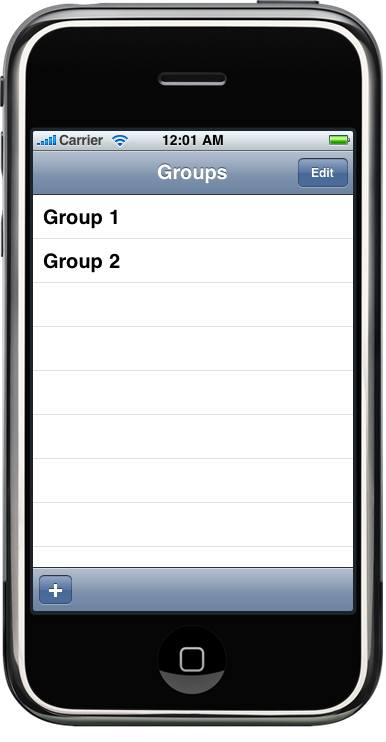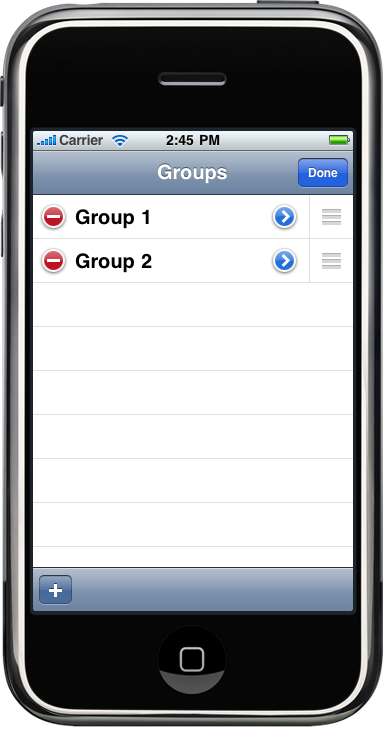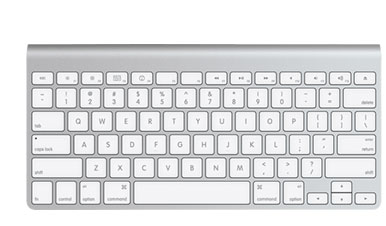In my last post, I decided to remove my Singleton object in preference for passing the `NSManagedObjectContext` around between view controllers. In my application, I have a table view that shows a list of ‘groups’, and a view that provides the form for entering or altering the group ‘title’.



The intention is to allow the user to both add new groups, and edit the titles of the existing groups. The same view can be used for both tasks, if setup correctly.
This raised some issues about how to efficiently code:
* Instantiation of the `GroupEditViewController`, providing the necessary inputs
* Deciding who should be responsible for saving changes to the objects
* Notifying the initiator that the Group Edit was complete.
## Definition of the Protocol
`GroupEditViewController` will be using a protocol that it’s delegate will implement, and we will define this as `GroupEditViewControllerDelegate` and place it in `GroupEditViewController.h`.
@protocol GroupEditViewControllerDelegate
-(void) groupEdit: (GroupEditViewController *) groupEdit didCompleteGroupEdit: (BOOL) didSave;
@end
We need to add properties to the class to store the instance variables passed in:
@interface GroupEditViewController : UIViewController
UITextField *groupTitle;
Group *group;
BOOL editing;
id delegate;
}
@property (nonatomic,retain) IBOutlet UITextField *groupTitle;
@property (nonatomic,retain) Group *group;
@property (nonatomic,assign,getter=isEditing) BOOL editing;
@property (nonatomic,assign) id <GroupEditViewControllerDelegate> delegate;
-(GroupEditViewController *) initWithGroup: (Group *) group forDelegate: (id
-(IBAction) didCancelGroupEdit;
-(IBAction) didCompleteGroupEdit;
@end
`GroupTableViewController` needs to specify that it implements the protocol in its @implementation statement:
@interface GroupTableViewController : UIViewController
< UITableViewDelegate,
UITableViewDataSource,
NSFetchedResultsControllerDelegate,
GroupEditViewControllerDelegate
> {
…
## Instantiation of the GroupEditViewController
I wanted a simple way of creating the `GroupEditViewController`, and decided that the class would benefit from a default initialiser that took the relevant inputs. Without the default initialiser, we would normally do
GroupEditViewController *groupEdit = [[GroupEditViewController alloc] init];
We need to provide:
* The group object to be edited (or created)
* The delegate for receiving notifications
* An indicator if the Group Edit view is editing an existing object
The following code is placed in `GroupTableViewController.m`, in my case this is in the `accessoryButtonTappedForRowWithIndexPath` method.
– (void) tableView:(UITableView *)tableView accessoryButtonTappedForRowWithIndexPath:(NSIndexPath *)indexPath {
Group *group = [self.fetchedResultsController objectAtIndexPath:indexPath];
GroupEditViewController *groupEdit = [[GroupEditViewController alloc] initWithGroup:group forDelegate:self isEditing:YES];
UINavigationController *navigationController = [[UINavigationController alloc] initWithRootViewController:groupEdit];
[self presentModalViewController:navigationController animated:YES];
[navigationController release];
[groupEdit release];
}
Note that in this instance we are editing an existing group object, which is retrieved from the `fetchedResultsController`. We also need a method to deal with the Add Group action when touching the toolbar button:
– (IBAction) didTouchAddGroupButton {
Group *group = [NSEntityDescription insertNewObjectForEntityForName:@”Group” inManagedObjectContext:self.managedObjectContext];
GroupEditViewController *groupEdit = [[GroupEditViewController alloc] initWithGroup:group forDelegate:self isEditing:NO];
UINavigationController *navigationController = [[UINavigationController alloc] initWithRootViewController:groupEdit];
[self presentModalViewController:navigationController animated:YES];
[navigationController release];
[groupEdit release];
}
Note that this time, we create a new Group object to pass to the `GroupEditViewController`.
We need to add the implementation of the default initializer to `GroupEditViewController.m`.
-(GroupEditViewController *) initWithGroup: (Group *) withGroup forDelegate: (id
self = [super init];
if (self) {
self.group = withGroup;
self.delegate = viewDelegate;
self.editing = isEditing;
}
return self;
}
## Deciding who should be responsible for saving changes
I decided that it was easier for the invoker, `GroupTableViewController`, to be responsible for the creation of new objects. When adding a new group, `GroupTableViewController` needs to create the new Group object, which may in turn be deleted by `GroupEditViewController` in the event of cancelling the edit.
## Notifying the initiator that the Group Edit was complete
Within `GroupEditViewController.m` we need to setup the view so that the navigation controller that it is placed within has the appropriate cancel and save buttons, and we’ll programmatically connect their actions to handling methods.
-(void) viewDidLoad {
[super viewDidLoad];
self.navigationItem.title = self.isEditing ? @”Edit Group” : @”Add Group”;
UIBarButtonItem *cancelButtonItem = [[UIBarButtonItem alloc] initWithTitle:@”Cancel” style:UIBarButtonItemStyleBordered target:self action:@selector(didCancelGroupEdit)];
self.navigationItem.leftBarButtonItem = cancelButtonItem;
[cancelButtonItem release];
UIBarButtonItem *saveButtonItem = [[UIBarButtonItem alloc] initWithTitle:@”Save” style:UIBarButtonItemStyleDone target:self action:@selector(didCompleteGroupEdit)];
self.navigationItem.rightBarButtonItem = saveButtonItem;
[saveButtonItem release];
self.groupTitle.text = self.group.title;
[self.groupTitle becomeFirstResponder];
}
We add methods to be the targets for the actions of the navigation buttons.
-(IBAction) didCancelGroupEdit {
if (self.isEditing == NO) {
[self.group.managedObjectContext deleteObject:self.group];
[self save];
}
[self.delegate groupEdit:self didCompleteGroupEdit: NO];
}
-(IBAction) didCompleteGroupEdit {
self.group.title = self.groupTitle.text;
[self save];
[self.delegate groupEdit:self didCompleteGroupEdit: YES];
}
And finally, in `GroupTableViewController.m`, we add the delegate to receive the notification that the edit was completed.
-(void) groupEdit:(GroupEditViewController *)groupEdit didCompleteGroupEdit:(BOOL)didSave {
[self dismissModalViewControllerAnimated:YES];
}



